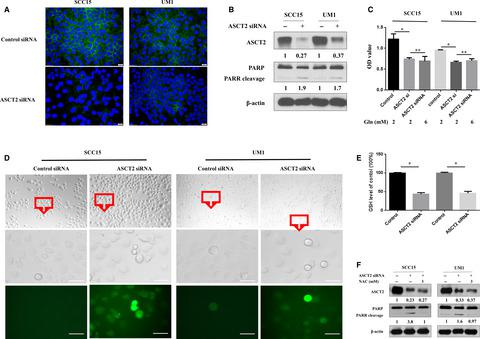当前位置:
X-MOL 学术
›
Cancer Med.
›
论文详情
Our official English website, www.x-mol.net, welcomes your feedback! (Note: you will need to create a separate account there.)
ASCT2 overexpression is associated with poor survival of OSCC patients and ASCT2 knockdown inhibited growth of glutamine-addicted OSCC cells.
Cancer Medicine ( IF 4 ) Pub Date : 2020-03-12 , DOI: 10.1002/cam4.2965 Yijun Luo 1 , Wei Li 1 , Zihang Ling 1 , Qinchao Hu 1 , Zhen Fan 2 , Bin Cheng 1 , Xiaoan Tao 1
Cancer Medicine ( IF 4 ) Pub Date : 2020-03-12 , DOI: 10.1002/cam4.2965 Yijun Luo 1 , Wei Li 1 , Zihang Ling 1 , Qinchao Hu 1 , Zhen Fan 2 , Bin Cheng 1 , Xiaoan Tao 1
Affiliation

|
BACKGROUND
Alanine-serine-cysteine transporter 2 (ASCT2), a major glutamine transporter, is essential for cell growth and tumor development in a variety of cancers. However, the clinicopathological significance and pathological role of ASCT2 in OSCC (oral squamous cell carcinoma) lesions remain unclear.
METHODS
Sections from 89 OSCC patients and 10 paracancerous tissue controls were stained by immunohistochemistry (IHC) to detect the expression of ASCT2, glutaminase, and Ki-67. Survival analysis was carried out to determine the predictive value of ASCT2 expression using the log-rank test. Moreover, the critical role of ASCT2 in tumor growth was determined by a series of in vitro and in vivo assays. Cell Counting Kit-8 (CCK8), Western Blotting (WB), Reactive Oxygen Species (ROS), and Glutathione (GSH) detection were applied to explore the molecular mechanism of ASCT2 involvement in tumor development.
RESULTS
In OSCC lesions, ASCT2 expression was significantly increased and associated with cell proliferation index (Ki-67) and GLS expression. Moreover, survival analysis showed that OSCC patients with high ASCT2 expression had lower overall survival (P = 0.0365). In OSCC cell lines, the high level of ASCT2 was inherent and related to the glutamine addiction of tumor cells. In vitro and in vivo functional experiments revealed that targeted silencing of ASCT2 can effectively inhibit OSCC cell proliferation and tumor growth. Mechanistically, targeting ASCT2 knockdown reduced glutamine uptake and intracellular GSH levels, which contribute to the accumulation of ROS and induce apoptosis in OSCC cells.
CONCLUSION
ASCT2 is a significant factor for predicting overall survival in patients with OSCC, and targeting ASCT2 to inhibit glutamine metabolism may be a promising strategy for OSCC treatment.
中文翻译:

ASCT2 过表达与 OSCC 患者的不良存活率相关,并且 ASCT2 敲低抑制了对谷氨酰胺成瘾的 OSCC 细胞的生长。
背景丙氨酸-丝氨酸-半胱氨酸转运蛋白2(ASCT2)是一种主要的谷氨酰胺转运蛋白,对多种癌症的细胞生长和肿瘤发展至关重要。然而,ASCT2在OSCC(口腔鳞状细胞癌)病变中的临床病理意义和病理作用仍不清楚。方法 89 例 OSCC 患者和 10 例癌旁组织对照的切片通过免疫组织化学 (IHC) 染色以检测 ASCT2、谷氨酰胺酶和 Ki-67 的表达。进行生存分析以使用对数秩检验确定 ASCT2 表达的预测值。此外,ASCT2 在肿瘤生长中的关键作用是通过一系列体外和体内测定确定的。Cell Counting Kit-8 (CCK8)、Western Blotting (WB)、活性氧 (ROS)、和谷胱甘肽(GSH)检测被应用于探索ASCT2参与肿瘤发展的分子机制。结果 在 OSCC 病变中,ASCT2 表达显着增加并与细胞增殖指数 (Ki-67) 和 GLS 表达相关。此外,生存分析表明,ASCT2 高表达的 OSCC 患者的总生存率较低(P = 0.0365)。在 OSCC 细胞系中,高水平的 ASCT2 是固有的,并且与肿瘤细胞的谷氨酰胺成瘾有关。体外和体内功能实验表明,靶向沉默 ASCT2 可以有效抑制 OSCC 细胞增殖和肿瘤生长。从机制上讲,靶向 ASCT2 敲低会降低谷氨酰胺摄取和细胞内 GSH 水平,这有助于 ROS 积累并诱导 OSCC 细胞凋亡。
更新日期:2020-03-12
中文翻译:

ASCT2 过表达与 OSCC 患者的不良存活率相关,并且 ASCT2 敲低抑制了对谷氨酰胺成瘾的 OSCC 细胞的生长。
背景丙氨酸-丝氨酸-半胱氨酸转运蛋白2(ASCT2)是一种主要的谷氨酰胺转运蛋白,对多种癌症的细胞生长和肿瘤发展至关重要。然而,ASCT2在OSCC(口腔鳞状细胞癌)病变中的临床病理意义和病理作用仍不清楚。方法 89 例 OSCC 患者和 10 例癌旁组织对照的切片通过免疫组织化学 (IHC) 染色以检测 ASCT2、谷氨酰胺酶和 Ki-67 的表达。进行生存分析以使用对数秩检验确定 ASCT2 表达的预测值。此外,ASCT2 在肿瘤生长中的关键作用是通过一系列体外和体内测定确定的。Cell Counting Kit-8 (CCK8)、Western Blotting (WB)、活性氧 (ROS)、和谷胱甘肽(GSH)检测被应用于探索ASCT2参与肿瘤发展的分子机制。结果 在 OSCC 病变中,ASCT2 表达显着增加并与细胞增殖指数 (Ki-67) 和 GLS 表达相关。此外,生存分析表明,ASCT2 高表达的 OSCC 患者的总生存率较低(P = 0.0365)。在 OSCC 细胞系中,高水平的 ASCT2 是固有的,并且与肿瘤细胞的谷氨酰胺成瘾有关。体外和体内功能实验表明,靶向沉默 ASCT2 可以有效抑制 OSCC 细胞增殖和肿瘤生长。从机制上讲,靶向 ASCT2 敲低会降低谷氨酰胺摄取和细胞内 GSH 水平,这有助于 ROS 积累并诱导 OSCC 细胞凋亡。


























 京公网安备 11010802027423号
京公网安备 11010802027423号